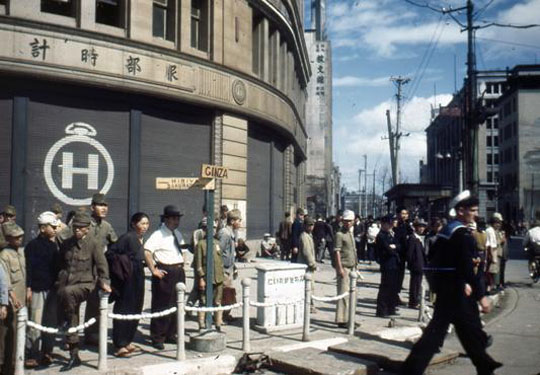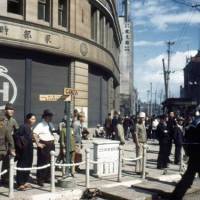The 10 years following the end of World War II in Tokyo are marked by two things — war-related devastation and the march toward reconstruction.
The exhibition "Tokyo Fukko" ("Reconstruction of Tokyo") at the Edo-Tokyo Museum captures this period of Tokyo's history through color photographs and movies, with many of the items being shown publicly for the first time.
The photographs and movies were taken by Americans Gaetano Faillace and Gotardo "Jim" Dilena.
Faillace was born in New York in 1904. After volunteering for the U.S. Army, he became an army cameraman for Gen. Douglas MacArthur, who later became supreme commander of the Allied Forces in Japan. Together with MacArthur, Faillace took part in campaigns in Leyte, Luzon and Manila. He is famous for a historic photograph showing MacArthur standing next to Emperor Showa on Sept. 27, 1945. Faillace died in 1991.
Dilena was born in 1918. He joined the U.S. Navy in 1940 and witnessed Japan's attack on Pearl Harbor and joined campaigns in the Southern Pacific and the Aleutian Islands. He lived in Tokyo and Yokosuka, Kanagawa Prefecture, from 1950 and worked as an intelligence officer for the U.S. naval headquarters. He died in 2008.
The exhibition is divided into several sections, the first two focusing on the devastation in Tokyo and its occupation. Other sections illustrate scenes of life in Tokyo that captivated U.S. audiences, and postoccupation Tokyo after the San Francisco Peace Treaty went into force on April 28, 1952, just before Tokyo began to experience a period of high economic growth.
The exhibition "Tokyo Fukko" ("Reconstruction of Tokyo") is currently being held at the Edo-Tokyo Museum in Tokyo. It is open from 9:30 a.m. till 5:30 p.m. (till 7:30 p.m. on Saturdays). The museum is closed on Mondays but open on Sept. 13 and 20. Admission price varies. For more information, visit www.edo-tokyo-museum.or.jp




















With your current subscription plan you can comment on stories. However, before writing your first comment, please create a display name in the Profile section of your subscriber account page.